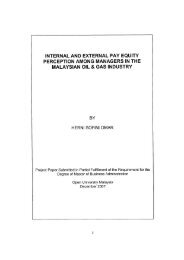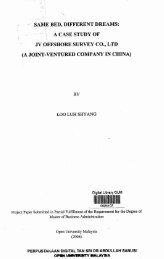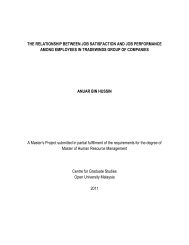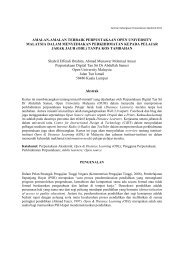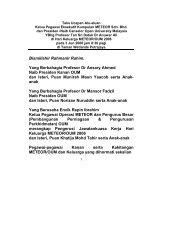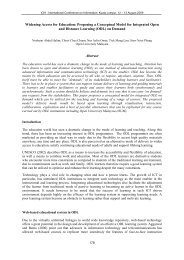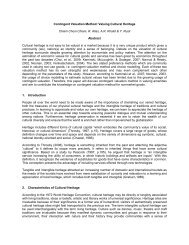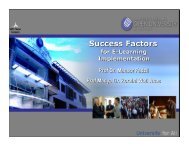Design of an Expert System to Enhance Learners' Critical Thinking ...
Design of an Expert System to Enhance Learners' Critical Thinking ...
Design of an Expert System to Enhance Learners' Critical Thinking ...
You also want an ePaper? Increase the reach of your titles
YUMPU automatically turns print PDFs into web optimized ePapers that Google loves.
<strong>Design</strong> <strong>of</strong> <strong>an</strong> <strong>Expert</strong> <strong>System</strong> <strong>to</strong> Enh<strong>an</strong>ce Learners’ <strong>Critical</strong> <strong>Thinking</strong> in aTask-based Online DiscussionN<strong>an</strong>tha Kumar Subram<strong>an</strong>iamFaculty <strong>of</strong> Information Technology & Multimedia CommunicationOpen University Malaysia (OUM), Malaysi<strong>an</strong><strong>an</strong>thakumar@oum.edu.myAbdullah Mohd ZinFaculty <strong>of</strong> Information Science <strong>an</strong>d TechnologyUniversity Keb<strong>an</strong>gsa<strong>an</strong> Malaysia (UKM), Malaysiaamz@ftskm.ukm.mySufi<strong>an</strong> IdrisFaculty <strong>of</strong> Information Science <strong>an</strong>d TechnologyUniversity Keb<strong>an</strong>gsa<strong>an</strong> Malaysia (UKM), Malaysiasi@ftsm.ukm.myAbstract: Teaching-Learning Process <strong>an</strong>d Technology components in the principles <strong>of</strong> effectiveness forserving adult learners are the most import<strong>an</strong>t elements in empowering learners <strong>to</strong> be the co-crea<strong>to</strong>rs <strong>of</strong> knowledge.There are various ways <strong>to</strong> blend teaching-learning process <strong>an</strong>d technology components <strong>to</strong> enrich educational experience forthe adult learners such as multimedia learning systems <strong>an</strong>d learning objects. In this paper, we will discuss <strong>of</strong> how we haveintegrated collaborative learning pedagogy <strong>an</strong>d asynchronous discussion board (forum) in order <strong>to</strong> design <strong>an</strong> expert systemwith the objective <strong>of</strong> promoting critical thinking aspects in a small group learning.Keywords: expert system, collaborative learning, critical thinking, asynchronous discussion board, adult learnersIntroductionOpen & dist<strong>an</strong>ce education (ODE) <strong>an</strong>d e-learning are fast becoming the way <strong>of</strong> providing education <strong>to</strong> the masses.ODE <strong>an</strong>d e-learning give opportunity for the working adults <strong>to</strong> enroll in programs that match their interest withoutleaving their job. Serving adult learners are more challenging th<strong>an</strong> serving in-campus students. According <strong>to</strong> CAEL(Council for Adult <strong>an</strong>d Experiential Learning, US), there are eight principles <strong>of</strong> effectiveness for serving adultlearners, namely outreach, life <strong>an</strong>d career pl<strong>an</strong>ning, fin<strong>an</strong>cing, assessment <strong>of</strong> learning outcome, teaching <strong>an</strong>dlearning process, student support systems, technology <strong>an</strong>d strategic partnerships.We consider the Teaching-Learning Process <strong>an</strong>d Technology components in the principles <strong>of</strong> effectiveness forserving adult learners as the most import<strong>an</strong>t elements in empowering learners <strong>to</strong> be the co-crea<strong>to</strong>rs <strong>of</strong> knowledge.There are various ways <strong>to</strong> blend teaching-learning process <strong>an</strong>d technology components <strong>to</strong> enrich educationalexperience for the adult learners such as multimedia learning systems (Sabatini 2001) <strong>an</strong>d learning objectsembedded with instructional design concepts. In this paper, we will discuss how we have integrated collaborativelearning pedagogy <strong>an</strong>d asynchronous discussion board (forum) in order <strong>to</strong> design <strong>an</strong> expert system that would beable <strong>to</strong> support the adult learners’ online collaborative learning via small groups with the emphasize <strong>to</strong> enh<strong>an</strong>ce thecritical thinking aspects <strong>of</strong> the groups <strong>an</strong>d its members. One main objective <strong>of</strong> asynchronous learning community isas place <strong>to</strong> create critical thinking that will lead <strong>to</strong> knowledge construction. Thus, critical thinking is <strong>an</strong> import<strong>an</strong>tcomponent in the students’ online discussion in small groups that have diversified learners. In proposing the designframework, the following theoretical frameworks were used:1. Collaborative learning pedagogy2. Garrison’s “community <strong>of</strong> inquiry” <strong>an</strong>d “practical inquiry” models for critical thinking (CT)- 4284 -
3. Newm<strong>an</strong>’s content <strong>an</strong>alysis model <strong>to</strong> calculate the CT ratioCollaborative LearningTheoretical FrameworkCollaborative learning is <strong>an</strong> established technique for teaching <strong>an</strong>d learning (Pres<strong>to</strong>n, 2005, Yerion d<strong>an</strong>Rinehart1995; Williams <strong>an</strong>d Kessler 2000; McKinney <strong>an</strong>d Den<strong>to</strong>n 2006) in which the students in a group have their ownlearning responsibilities for each other <strong>an</strong>d for themselves (Gokhale 1995). According <strong>to</strong> Pres<strong>to</strong>n (2005), this is asocial process (Bagley <strong>an</strong>d Chou, 2007) in which the learners learnt from peers by participating interactively withlearning material, observing the solution approach adopted by every peers, ensure each peer is focused <strong>to</strong>wards thetask <strong>an</strong>d motivated in highlighting issues <strong>an</strong>d decisions. The potential benefits that c<strong>an</strong> be obtained by the learnerslearning through collaborative learning are (Wilson JD, Hoskin N d<strong>an</strong> Nosek JT 1993, Yerion KA d<strong>an</strong> Rinehart JA1995, Williams L <strong>an</strong>d Kessler RR 2000, McKinney D <strong>an</strong>d Den<strong>to</strong>n LF 2006) resource sharing <strong>an</strong>d cohesivebrains<strong>to</strong>rming, moni<strong>to</strong>ring <strong>of</strong> the problem solution approach by the peers, interactive is conducive for the goodperform<strong>an</strong>ce, positive effects on the cognitive growth <strong>an</strong>d tr<strong>an</strong>smission <strong>an</strong>d acquisition <strong>of</strong> kills, development <strong>of</strong>interest <strong>an</strong>d sense <strong>of</strong> belonging, help the learners in applying problem solving techniques which is more algorithmic,sustainable deep learning, good perform<strong>an</strong>ce achievement, increase the confidence level in giving the solutions <strong>an</strong>dsatisfaction on the process that was experienced. Collaborative learning could also be supported using computerthrough the Computer Supported Collaborative Learning (CSCL). This c<strong>an</strong> be done using online visualization <strong>to</strong>ols,community <strong>to</strong>ols, chat <strong>an</strong>d discussion forums. Asynchronous-based discussion <strong>to</strong>ols such as discussion board orthreaded forums facilitate communication among the learners which c<strong>an</strong> be archived for reference. It also givesspace <strong>to</strong> the students <strong>to</strong> think what <strong>to</strong> be typed in the discussion board (i.e. enables reflections). Numerousresearches have highlighted the effectiveness <strong>of</strong> asynchronous communication as a learning source. The prominentresearch in this field was conducted by (Harasim 1990). Harasim discovered asynchronous environment c<strong>an</strong> be used<strong>to</strong> enh<strong>an</strong>ce the learning process. This c<strong>an</strong> be achieved through the combination <strong>of</strong> active learning <strong>an</strong>d knowledgeconstruction. Environments that have the interactive <strong>an</strong>d asynchronous aspects enable active learning. According <strong>to</strong>Harasim, knowledge is constructed through generation, linkage <strong>an</strong>d structuring <strong>of</strong> idea through online mode <strong>of</strong>communication. (Hiltz <strong>an</strong>d Wellm<strong>an</strong> 1997) in their studies found that asynchronous discussion is sufficient <strong>to</strong>support the development <strong>of</strong> learning community in which the students establish the both elements <strong>of</strong> cognitive <strong>an</strong>demotions needed for effective learning.Garrison’s Model <strong>of</strong> <strong>Critical</strong> <strong>Thinking</strong>The import<strong>an</strong>ce <strong>of</strong> cognitive development in online learning has been supported by (Garrison, D. R., Anderson, T.,& Archer, W. 2000) <strong>an</strong>d (Garrison, D. R., Anderson, T., & Archer, W. 2001) who believe with the creation <strong>of</strong>“community <strong>of</strong> inquiry” as a base for the development <strong>of</strong> critical thinking skills in online discussion. “Community<strong>of</strong> Inquiry” is characterized by question driven, critical discourse <strong>an</strong>d information gathering among the learners.This model assumes that learning occurs in a community through the interactions <strong>of</strong> three elements, namelycognitive presence, social presence <strong>an</strong>d teaching presence. According <strong>to</strong> (Garrison, D. R., Anderson, T., & Archer,W. 2000), cognitive element is the most import<strong>an</strong>t element for the successful online learning. In order <strong>to</strong> betterunderst<strong>an</strong>d cognitive presence in “Community <strong>of</strong> Inquiry”, (Garrison, D. R., Anderson, T., & Archer, W. 2001) havedeveloped <strong>an</strong>other model known as “practical inquiry model”. In this “practical inquiry model”, cognitive presenceis operationalized through four pre-defined phases in which the active construction <strong>of</strong> knowledge occurs throughthe sequence <strong>of</strong> this phase. The first phase <strong>of</strong> the model reflects the initiation phase <strong>of</strong> critical inquiry <strong>an</strong>d isconsidered the triggering event. Here <strong>an</strong> issue, dilemma, or problem that emerges from experience is identified orrecognized. The second phase <strong>of</strong> the process is exploration. In this phase, students are required <strong>to</strong> perceive or graspthe nature <strong>of</strong> the problem, <strong>an</strong>d then move <strong>to</strong> a fuller exploration <strong>of</strong> relev<strong>an</strong>t information. The third phase, integration,is characterized by constructing me<strong>an</strong>ing from the ideas generated in the explora<strong>to</strong>ry phase. During the tr<strong>an</strong>sitionfrom the explora<strong>to</strong>ry phase, students will begin <strong>to</strong> assess the applicability <strong>of</strong> ideas in terms <strong>of</strong> how well they connect<strong>an</strong>d describe the issue or event under consideration. The fourth phase is a resolution <strong>of</strong> the dilemma or problem byme<strong>an</strong>s <strong>of</strong> direct or vicarious action. In all these phases, particip<strong>an</strong>ts shift between the private, reflective world <strong>of</strong> theindividual <strong>an</strong>d the social exploration <strong>of</strong> ideas. The “practical inquiry” model shows clearly all the critical thinkingprocesses that need <strong>to</strong> be experienced by the students <strong>to</strong> achieve cognitive presence in “community <strong>of</strong> inquiry”.- 4285 -
Newm<strong>an</strong> Model <strong>of</strong> Content AnalysisThere are various pro<strong>to</strong>cols that have been developed <strong>to</strong> calculate critical thinking (CT) ratio in order <strong>to</strong> perform thecontent <strong>an</strong>alysis (i.e. <strong>an</strong>alyzing the learners’ tr<strong>an</strong>script). Each <strong>of</strong> these has different scopes <strong>an</strong>d objectives. We haveadopted Newm<strong>an</strong> content <strong>an</strong>alysis model (Newm<strong>an</strong>, D. R., Webb, B., & Cochr<strong>an</strong>e, C. 1995) as it is based onGarrison’s “practical inquiry” model which is also a framework used in this study. Newm<strong>an</strong>’s content <strong>an</strong>alysismodel has inst<strong>an</strong>tiated indica<strong>to</strong>rs <strong>of</strong> critical thinking via approximately 40 codes in categories such as relev<strong>an</strong>ce,justification, novelty, <strong>an</strong>d ambiguities, each with a plus or a minus appended <strong>to</strong> indicate whether the coded statementcontributes <strong>to</strong> (+) or detracts from (–) critical thinking development. This model proposes several sets <strong>of</strong> pairedindica<strong>to</strong>rs – twenty pairs, five independent positive indica<strong>to</strong>rs <strong>an</strong>d one independent indica<strong>to</strong>r. They indicate thatraters are <strong>to</strong> mark <strong>an</strong>d count only obvious statements, which c<strong>an</strong> be phrases, sentences, paragraphs, or messagescontaining one unit <strong>of</strong> me<strong>an</strong>ing illustrating one or more <strong>of</strong> the indica<strong>to</strong>rs. Once a passage is coded, one calculates acritical thinking ratio as: CT = (x+ – x–)÷(x+ + x–) where x+ is the count <strong>of</strong> statements contributing <strong>to</strong> criticalthinking for the coding category <strong>an</strong>d x– is the count <strong>of</strong> statements detracting from critical thinking for the category.Positive numbers approaching 1 indicate the highest levels <strong>of</strong> critical thinking. Overall critical thinking ratio c<strong>an</strong> becalculated by counting all the positive <strong>an</strong>d negative postings in the forum <strong>an</strong>d then apply the above formula.(Newm<strong>an</strong>, Webb <strong>an</strong>d Cochr<strong>an</strong>e 1995) also have mapped the relev<strong>an</strong>t indica<strong>to</strong>rs <strong>of</strong> content <strong>an</strong>alysis <strong>to</strong> each <strong>of</strong> thephases in the Garrison’s “practical inquiry” model. This has made Newm<strong>an</strong>’s content <strong>an</strong>alysis model <strong>an</strong>d Garrison’s“practical inquiry” model compatible <strong>to</strong> each other. The following figure summarizes <strong>of</strong> how each theoreticalframework used in this study contribute <strong>to</strong> the development <strong>of</strong> the expert system.The Proposed ArchitectureFigure 1: Main Components <strong>of</strong> the <strong>System</strong>Figure 1 shows the components that make up the proposed system. The proposed system will use agent approachbased on rule-based expert system in making the decisions. The rules will be built using Jess (Java <strong>Expert</strong> <strong>System</strong>Shell) inference engine that uses forward chaining algorithm. The facts <strong>an</strong>d rules for the agents will be s<strong>to</strong>red inJess working memory <strong>an</strong>d knowledge base respectively. The agent approach is adopted because it is goal oriented,take actions when necessary <strong>to</strong> achieve the goals, capable <strong>to</strong> complete the task given by the user, capable <strong>to</strong> moni<strong>to</strong>rthe environment <strong>an</strong>d adjust the event without the intervention from the user. In discussions using forums, the taskthat c<strong>an</strong> be done by the agents are sending messages <strong>to</strong> the students, classify the messages posted by the learners <strong>an</strong>dmodels the conversation among the learners in the discussion group.Students will be given a task or problem <strong>to</strong> be solved thorough collaborative discussion. They will be separated ingroups which has two <strong>to</strong> three learners since effective collaboration learning only c<strong>an</strong> be achieved if the number <strong>of</strong>the students in group is between two <strong>to</strong> six (Kovacs 1982). In order <strong>to</strong> do the discussion, the students will post their- 4286 -
message in the asynchronous forum using sentence openers provided in the forum. Only one sentence opener c<strong>an</strong> beused per posting <strong>to</strong> start the discourse. Subsequent sentences in the same posting should not use <strong>an</strong>y sentenceopener.There is no restriction on the number <strong>of</strong> words per posting but each posting (which may consists more th<strong>an</strong> onesentence) must highlight a single issue. This will enable the agents <strong>to</strong> do their tasks efficiently. Sentence openers arepre-defined approach <strong>to</strong> start a conversation using menu or but<strong>to</strong>ns. We are motivated <strong>to</strong> use sentence openers basedon the result obtained by Baker <strong>an</strong>d Lund (1996). Baker <strong>an</strong>d Lund (1996) compared the problem solving behavior <strong>of</strong>student pairs as they communicated through both a sentence opener interface <strong>an</strong>d <strong>an</strong> unstructured chat interface.They found that the dialogue between students who used the sentence opener interface was more task focused.In this study, the sentence opener that we have adopted is based on the Collaborative Learning Conversation SkillTaxonomy as suggested by (Soller et al. 1998) <strong>an</strong>d (Soller 1996). This Collaborative Learning Conversation SkillTaxonomy illustrates the conversation skills most <strong>of</strong>ten exhibited during collaborative learning <strong>an</strong>d problem solving.It breaks down each learning conversation skill type (Active Learning, Conversation, <strong>an</strong>d Creative Conflict) in<strong>to</strong> itscorresponding subskills (e.g. Request, Inform, Acknowledge), <strong>an</strong>d attributes (e.g. Suggest, Rephrase). Each attributeis assigned a short introduc<strong>to</strong>ry phrase, or sentence opener, which conveys the appropriate dialogue intention (Solleret al. 1998) <strong>an</strong>d (Soller 1996). There are 36 sentence openers in this taxonomy. The used <strong>of</strong> sentence opener inintelligent collaborative system is not something new. Sentence opener has been used in CSiLE (Bereiter <strong>an</strong>dScardamalia 1987) <strong>an</strong>d in Group Leader (McM<strong>an</strong>us <strong>an</strong>d Aiken 1995). CSiLE is developed <strong>to</strong> increase the number <strong>of</strong>posting from the students. On the other h<strong>an</strong>d, Group Leader compare sequences <strong>of</strong> students’ conversation acts <strong>to</strong>those allowable in a four finite state machines developed specifically <strong>to</strong> moni<strong>to</strong>r discussions about comments,requests, promises, <strong>an</strong>d debates.In our proposed expert system, each message typed by the students will first be parsed by the Message Classifieragent which will do the following tasks daily:(i) Identify which sentence opener that has been used by the students(ii) Identify the main keywords used by the students in completing the sentence (sentence closer) using thesentence opener(iii) Based on the sentence opener <strong>an</strong>d sentence closer used by the students, the agent will classify themessage as either discussion messages, not relev<strong>an</strong>t message (such as “how are you?”) or specificquestion from the students on the domain or problem that need <strong>to</strong> be solved. The agent will ignore <strong>an</strong>yother message that could not be classified.(iv) If the message is classified as discussion message, the agent will assign appropriate indica<strong>to</strong>r(s)available in Newm<strong>an</strong>’s content <strong>an</strong>alysis model (Newm<strong>an</strong>, D. R., Webb, B., & Cochr<strong>an</strong>e, C. 1995). Herea message c<strong>an</strong> have more th<strong>an</strong> one indica<strong>to</strong>r depends on the keyword used in the sentence closer.(v) The agent will send reminder <strong>to</strong> the students if they do not use the sentence opener at all in drafting theirmessage or inappropriate use <strong>of</strong> the sentence opener (such as “I agree not <strong>to</strong> agree”)(vi) If the message is classified as question asking on the domain or about the problem, the QuestionAnswering agent will <strong>an</strong>swer the question by giving few possible <strong>an</strong>swers <strong>to</strong> the questions asked by thestudent earlier. If this agent could not <strong>an</strong>swer the question, it will ask the instruc<strong>to</strong>r/tu<strong>to</strong>r <strong>to</strong> <strong>an</strong>swer it.After the Message Classifier agent performed its tasks, the Pedagogical Agent will swing in<strong>to</strong> action (2 times in aweek) <strong>to</strong> do the following tasks using all the messages classified as discussion messages <strong>an</strong>d has been assigned thecontent <strong>an</strong>alysis indica<strong>to</strong>rs by the Message Classifier agent earlier:(i)(ii)(iii)Calculate the critical thinking (CT) ratio <strong>of</strong> the individual learners <strong>an</strong>d the groups for each <strong>of</strong> thecategory in the Newm<strong>an</strong>’s content <strong>an</strong>alysis model (Newm<strong>an</strong>, D. R., Webb, B., & Cochr<strong>an</strong>e, C. 1995). Incalculating the CT ratio, only the messages that relev<strong>an</strong>t <strong>to</strong> the current Garrison stages will be taken in<strong>to</strong>consideration. Other messages which are considered not relev<strong>an</strong>t for current phase will be ignored. ThePhase Update Counter keep track on the progress <strong>of</strong> the phases.Identify the number <strong>of</strong> messages that are <strong>of</strong>f <strong>to</strong>picMoni<strong>to</strong>r learners’ <strong>an</strong>d groups’ CT ratio in moving from one phase <strong>to</strong> the <strong>an</strong>other- 4287 -
(iii)(iv)Based on (i) <strong>an</strong>d (ii) above, the Pedagogical agent will give its feedback, advice or consultation <strong>to</strong> thestudents or/<strong>an</strong>d their group if:-CT ratios <strong>of</strong> the student <strong>an</strong>d/or the group is very far from 1-There is a big difference between individual CT <strong>an</strong>d his/her group’s CT-Too m<strong>an</strong>y <strong>of</strong>f <strong>to</strong>pic postings- Lack <strong>of</strong> progress in terms <strong>of</strong> CT ratios <strong>of</strong> the individual learners <strong>an</strong>d his/her group’s in moving fromone phase <strong>to</strong> the next phaseFinally, the student model will be updated accordingly by this agentThe Moni<strong>to</strong>r Agent will moni<strong>to</strong>r students’ participation level in the discussion forum. This agent will sendpostings/message or reminders in the forum <strong>to</strong> the students who are not active by asking them <strong>to</strong> participate activelyin the discussions. This is <strong>to</strong> ensure that there are plenty <strong>of</strong> postings so that other agents c<strong>an</strong> perform their tasks.This agent will perform its task for every four days. This agent will also submit the participation report <strong>to</strong> theinstruc<strong>to</strong>r as well for follow-up actions.(Newm<strong>an</strong>, Webb <strong>an</strong>d Cochr<strong>an</strong>e (1995 also have mapped the relev<strong>an</strong>t indica<strong>to</strong>rs <strong>of</strong> content <strong>an</strong>alysis <strong>to</strong> each <strong>of</strong> thephases in the Garrison’s “practical inquiry” model. .The Relev<strong>an</strong>cy Agent will use this mapping information <strong>to</strong> givereminders <strong>to</strong> the students if message posted by them is not appropriate for the current phase that they are currentlyin. This is <strong>to</strong> ensure that the students are in the same level <strong>of</strong> discussion <strong>an</strong>d there are no students ahead or left out inthe discussion. On the other h<strong>an</strong>d, Phase update counter will keep track in the tr<strong>an</strong>sition <strong>of</strong> the phases in theGarrison’s “practical inquiry” model. Phase Update Counter has its own schedule in order <strong>to</strong> update the phase.Phase update counter has influence on the Pedagogical <strong>an</strong>d Relev<strong>an</strong>cy agents as information from Phase UpdateCounter is used by Relev<strong>an</strong>cy <strong>an</strong>d Pedagogical agents in executing their tasks.Each individual Student Model <strong>an</strong>d the Group Model will include all the relev<strong>an</strong>t information that are needed by theagents in executing their task. The relev<strong>an</strong>t agents will give more attention <strong>to</strong> the learners who have CGPA below2.5. Information in students’ <strong>an</strong>d groups’ model will be updated accordingly by the relev<strong>an</strong>t agents as they performtheir tasks.ConclusionThis paper has proposes <strong>an</strong> architecture for <strong>an</strong> expert system <strong>to</strong> enh<strong>an</strong>ce learners critical thinking in solving atask/problem online collaboratively through asynchronous discussion board (forum). This study is conducted inpremise <strong>of</strong> that the learners learning is not so much a matter <strong>of</strong> building up correct responses or eliminatingincorrect responses. The most import<strong>an</strong>t thing is for students <strong>to</strong> have the opportunity in a group <strong>to</strong> test the adequacy<strong>of</strong> their ideas. It is how critical thinking skills are developed in the online group discussion. Currently we are in theprocess <strong>of</strong> developing the system. The testing <strong>of</strong> the system is scheduled in May 2010.ReferencesBagley, C., & Chou, C. C. (2007). Collaboration <strong>an</strong>d the import<strong>an</strong>ce for novices in learning java computer programming. ACMSIGCSE Bulletin, 39(3), 211-215.Bereiter, C., & Scardamalia, M. (1987). The psychology <strong>of</strong> written composition. Hilldale: Erlbaum.Baker, M. & Lund, K. (1996). Flexibly structuring the interaction in a CSCL environment. Proceedings <strong>of</strong> the Europe<strong>an</strong>Conference on Artificial Intelligence in Education (EuroAIED â96), 401-407.Dawn McKinney, Leo F. Den<strong>to</strong>n: Developing collaborative skills early in the CS curriculum in a labora<strong>to</strong>ry environment.SIGCSE 2006: 138-142- 4288 -
Garrison, D. R., Anderson, T., & Archer,W. (2000). <strong>Critical</strong> inquiry in a text-based environment: Computer conferencing inhigher education. The Internet <strong>an</strong>d Higher Education, 2(2-3), 87-105.Garrison, D. R., Anderson, T., & Archer, W. (2001). <strong>Critical</strong> thinking, cognitive presence, <strong>an</strong>d computer conferencing in dist<strong>an</strong>ceeducation. Americ<strong>an</strong> Journal <strong>of</strong> Dist<strong>an</strong>ce Education, 15 (1) 7-23.Gokhale, A. (1995). Collaborative learning enh<strong>an</strong>ces critical thinking. Journal <strong>of</strong> Technology Education, 7, 1-2.Harasim, L. M. (1990). Online education: An environment for collaboration <strong>an</strong>d intellectual amplification. In L. M. Harasim(Ed.), Online Education: Perspectives on a New Environment (pp. 39-64). NY: Praeaer.Hiltz, S. R. <strong>an</strong>d Wellm<strong>an</strong>, B. 1997. Asynchronous learning networks as a virtual classroom. Communications <strong>of</strong> the ACM, Vol.40, N. 9, September, pp. 44-49.L A Williams, R R Kessler . All I really need <strong>to</strong> know about pair programming I learned in kindergarten (2000). Communications<strong>of</strong> the ACMMcDowell, C., Linda W., Bullock, H.E. & Fernald, J. (2003). The Impact <strong>of</strong> Pair Programming on Student Perform<strong>an</strong>ce,Perception <strong>an</strong>d Persistence. Proceedings <strong>of</strong> the 25th International Conference on S<strong>of</strong>tware Engineering (ICSE'03).Newm<strong>an</strong>, D. R., Webb, B., & Cochr<strong>an</strong>e, C. (1995). A content <strong>an</strong>alysis method <strong>to</strong> measure critical thinking in face-<strong>to</strong>-face <strong>an</strong>dcomputer supported group learning. Interpersonal Computing <strong>an</strong>d Technology, 3 (2), 56-77.Pres<strong>to</strong>n, D. (2005). Pair Programming as a Model <strong>of</strong> Collaborative Learning: A Review <strong>of</strong> the Research. Journal <strong>of</strong> Consortiumfor Computing Sciences in Colleges (JCSC), 20:4(2005).Sabatini, J. P. (2001). <strong>Design</strong>ing multimedia learning systems for adult learners: Basic skills with a workforce emphasis. NationalCenter on Adult Literacy, University <strong>of</strong> Pennsylv<strong>an</strong>ia, NCAL Working Paper WP00-01.Soller, A., Goodm<strong>an</strong>, B., Lin<strong>to</strong>n, F., & Gaimari, R. (1998) Promoting Effective Peer Interaction in <strong>an</strong> Intelligent CollaborativeLearning Environment. Proceedings <strong>of</strong> the Fourth International Conference on Intelligent Tu<strong>to</strong>ring <strong>System</strong>s (ITS 98), S<strong>an</strong>An<strong>to</strong>nio, TX, 186-195.Soller, A. (1996) EXACT: A <strong>System</strong> for Expl<strong>an</strong>a<strong>to</strong>ry Argumentation within Intelligent Instructional Environments.Undergraduate Honors Thesis, MITRE Technical Report MTR96B32.Wilson JD, Hoskin N, & Nosek JT. (1993). The Benefits <strong>of</strong> Collaboration for Student Programmers. Paper presented at the 24thSIGCSE Technical Symposium on Computer Science Education SIGCSE 1993, Indi<strong>an</strong>apolis, Indi<strong>an</strong>a US.Yerion KA <strong>an</strong>d Rinehart JA (1995). "Guidelines for Collaborative Learning in Computer Science." ACM SIGSCSE Bulletin27(4).Z. Kovacs, Group decision making under uncertainty: group structure <strong>an</strong>d the shift phenomenon in: H. Br<strong>an</strong>dstatter, J.H. Davis,G. S<strong>to</strong>cher-Kreichgauer (Eds.), Contemporary Problems in Group Decision Making, Academic Press, New York, 1982, pp. 201–214.- 4289 -



